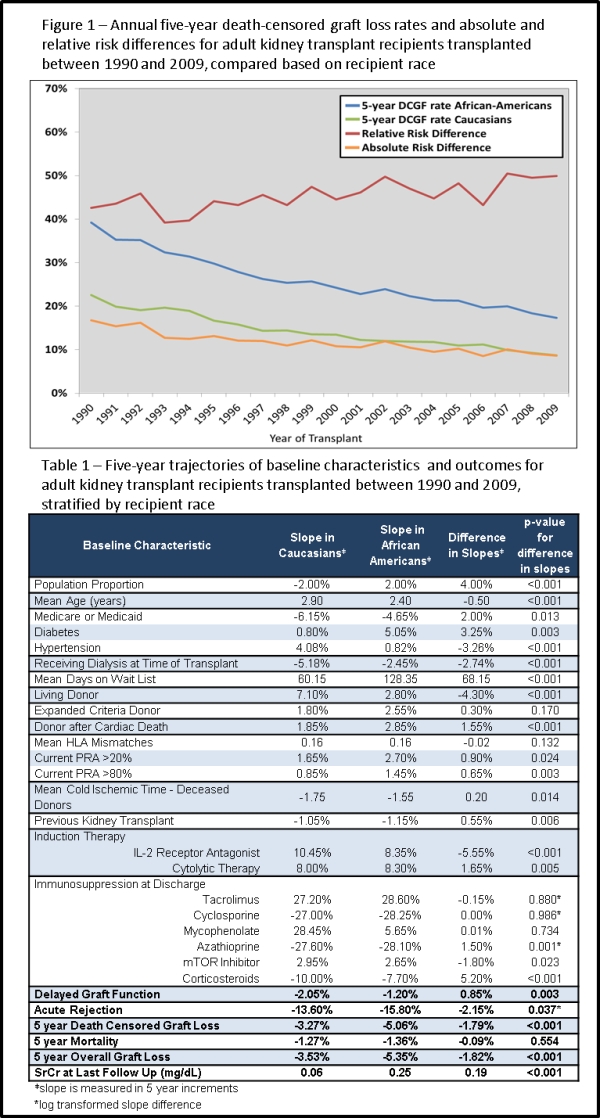Twenty Years of Evolving Trends in Racial Disparities for Adult Kidney Transplant Recipients.
Med Univ of South Carolina, Charleston, SC.
Meeting: 2016 American Transplant Congress
Abstract number: 384
Keywords: African-American, Allocation, Donation, Kidney transplantation
Session Information
Session Name: Concurrent Session: Disparities in Transplant Access and Outcomes
Session Type: Concurrent Session
Date: Tuesday, June 14, 2016
Session Time: 2:30pm-4:00pm
 Presentation Time: 3:42pm-3:54pm
Presentation Time: 3:42pm-3:54pm
Location: Room 312
Objective: To determine if baseline risks and post-transplant outcome disparities in African American (AA) kidney transplant recipients have evolved over time.
Methods: Analysis of 20-years of U.S. national transplant registry data, compiled by UNOS. All adult Caucasian or AA solitary kidney recipients transplanted between 1990 and 2009 within the U.S. were included; totaling 202,085 transplants, 144,081 (71%) Caucasian and 58,004 (29%) AA recipients. Annual trends were estimated using regressed slopes and compared by race using standard statistical methods.
Results: Between 1990-2009, the rate of death censored graft loss at 5-years post-transplant decreased for the entire cohort, from 26.6% in 1990 to 11.5% in 2009; with the rate declining more precipitously in AAs, as compared to Caucasians (5 year slope difference: -1.8%; p<0.001, see Figure 1). Mortality rates at 5-years post-transplant also declined at a comparable magnitude (1990: 15.9%; 2009: 9.4%), which was similar between AA and Caucasians (slope difference: -0.09% per 5 years; p=0.554). Other notable trends that significantly differed by race included: increased rate of diabetes in AAs (5 year slope difference: 3.25%; p=0.003), fewer living donors in AAs (5 year slope difference: -4.30%; p<0.001), more DCD donors in AAs (5 year slope difference: 1.55%; p<0.001), faster decline in the rates of acute rejection in AAs (5 year slope difference: -2.15%; p=0.037) and a slower decline in delayed graft function rates in AAs (5 year slope difference: 0.85%; p=0.003, see Table 1).
Conclusion: These data provide a mixed picture of both promising and concerning trends in disparities for AA kidney transplant recipients. Although the disparity for the post-transplant outcomes of acute rejection and 5 year death censored graft loss rates has significantly improved between 1990 and 2009, equity is still far off and other disparities, including reductions in living donation rates, increased use of marginal donor and delayed graft function rates, have widened during this same time period.

CITATION INFORMATION: Taber D, Gebregziabher M, Chavin K, Srinivas T, Baliga P, Egede L. Twenty Years of Evolving Trends in Racial Disparities for Adult Kidney Transplant Recipients. Am J Transplant. 2016;16 (suppl 3).
To cite this abstract in AMA style:
Taber D, Gebregziabher M, Chavin K, Srinivas T, Baliga P, Egede L. Twenty Years of Evolving Trends in Racial Disparities for Adult Kidney Transplant Recipients. [abstract]. Am J Transplant. 2016; 16 (suppl 3). https://atcmeetingabstracts.com/abstract/twenty-years-of-evolving-trends-in-racial-disparities-for-adult-kidney-transplant-recipients/. Accessed December 20, 2025.« Back to 2016 American Transplant Congress
